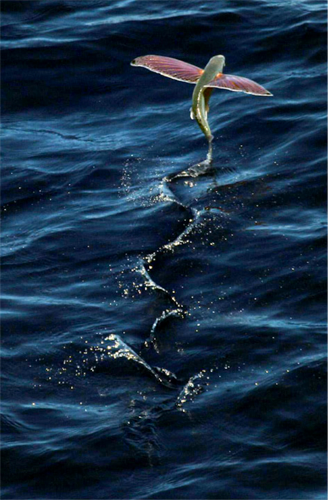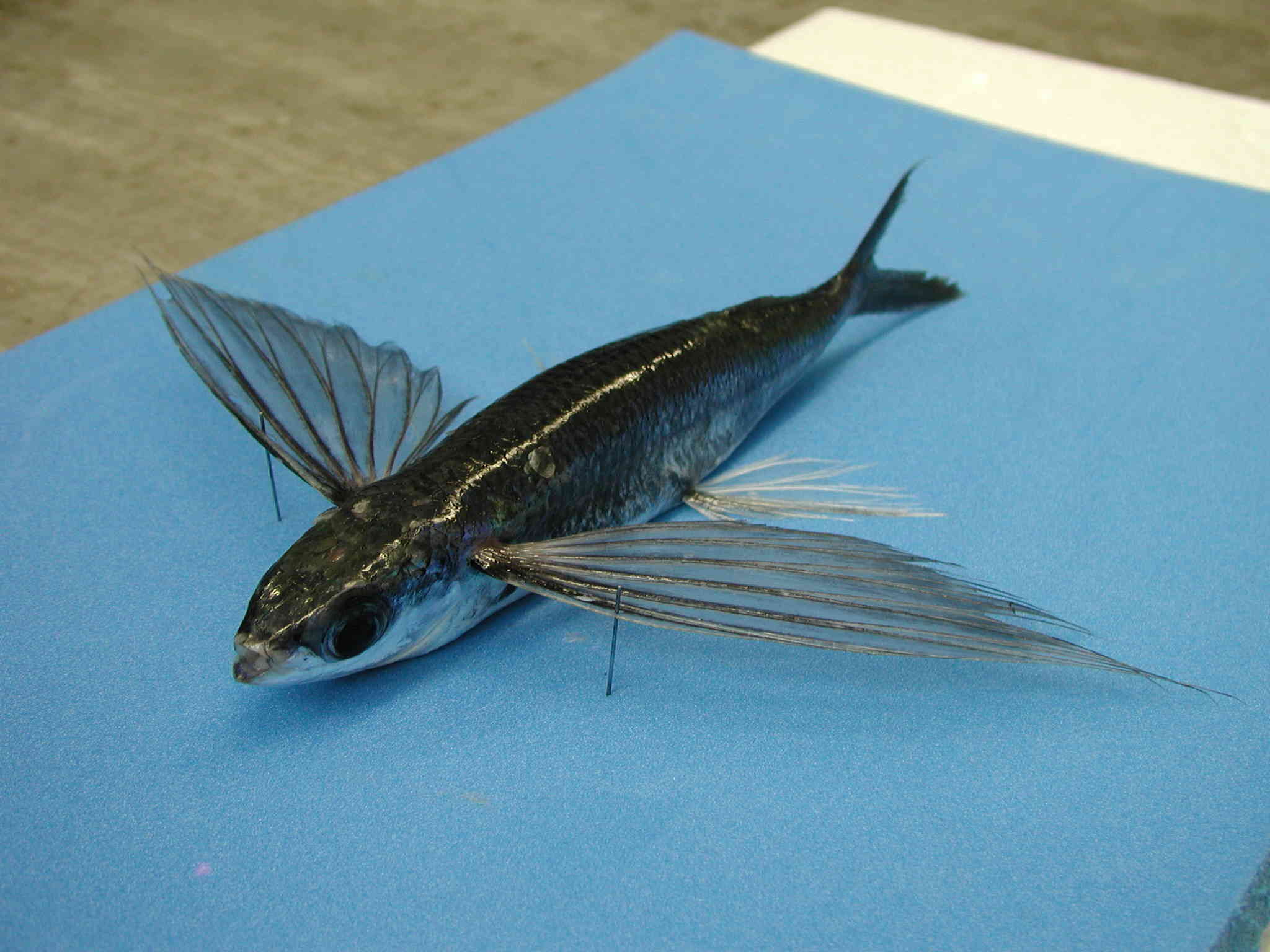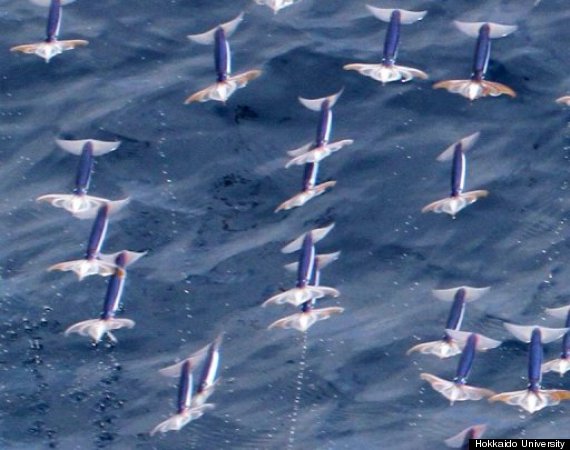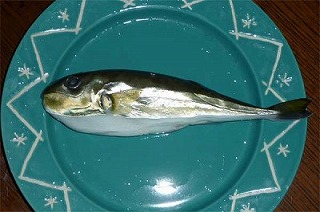
photo via: montessori.vacodi.com
if you don't like this video below.
please don't continue, and follow this thread anymore.
closed no more and that will an end of this thread.
sure you like it.
video.
Now you know,


photo via: montessori.vacodi.com
Stayed tune more interesting thing from Kyushu.
 Ikan Terbang
Ikan Terbang
ไข่à¸�ุ้งที่ใช้ในà¸à¸²à¸«à¸²à¸£à¸�ี่ปุ่น จริงๆ à¹�ล้วมันคืà¸à¹„ข่ขà¸à¸‡à¸à¸°à¹„ร
เรื่à¸à¸‡à¹‚ดย : ทีมงาน www.marumura.com
คุณรู้หรืà¸à¹„ม่ว่า “ไข่à¸�ุ้ง” ที่ใช้ในà¸à¸²à¸«à¸²à¸£à¸�ี่ปุ่นจำพวà¸� Sushi หรืภCalifornia rolls นั้น จริงๆ à¹�ล้วมันคืภ“ไข่ปลา Tobiuo :トビウオ(飛éš): Flying Fish” คนà¸�ี่ปุ่นจึงเรียà¸�ไข่ปลาชนิดนี้ว่า “Tobiko ã�¨ã�³ã�“” 

Tobiuo หรืภFlying Fish เป็นปลาที่พบตามชายà¸�ั่งทางตà¸à¸™à¹ƒà¸•à¹‰à¸‚à¸à¸‡à¸›à¸£à¸°à¹€à¸—ศà¸�ี่ปุ่น (Kyushu) สำหรับปลาประเภทนี้มีà¸à¸¢à¸¹à¹ˆà¸›à¸£à¸°à¸¡à¸²à¸“ 50 สายพันธุ์ทั่วโลà¸� à¹�ละสายพันธุ์ที่พบในประเทศà¸�ี่ปุ่นà¸�็มีมาà¸�ถึง 30 สายพันธุ์ ปลาประเภทนี้จะลำตัวมีความยาว 35 ซ.ม. จุดเด่นคืà¸à¸„รีบà¸à¸�ขนาดใหà¸�่ ยาวà¸à¸à¸�มาลัà¸�ษณะคล้ายปีà¸� เมื่à¸à¸§à¹ˆà¸²à¸¢à¸”้วยความเร็วสูง à¹�ล้วà¸�างครีบà¸à¸�à¸à¸à¸� จะพุ่งขึ้นเหนืà¸à¸™à¹‰à¸³à¹�ละสามารถร่à¸à¸™à¹€à¸¥à¸µà¸¢à¸šà¸œà¸´à¸§à¸™à¹‰à¸³à¹„ปได้ในระยะทางไà¸�ลๆ โดยขึ้นà¸à¸¢à¸¹à¹ˆà¸�ับขนาดปลาà¹�ละจังหวะในà¸�ารร่à¸à¸™
เครดิต:http://www.dek-d.com/board/view.php?id=2509337
Also known as the Japanese Common Squid, the Japanese Flying Squid is part of the Ommastrephidae family. It lives in the northern Pacific Ocean around Japan, and up to the coast of China, Russia, and across the Bering Straight towards lower Alaska and Canada. Clusters of the Japanese Flying Squid are also found in the central region of Vietnam. The Japanese Flying Squid can live in cold temperature, from 5° to 27°C.
Adult squids have a few distinguishing features. They have a mantle which encloses the visceral mass. They also have 2 fins, a siphon used for jet propulsion, and 8 arms and 2 tentacles that have suction cups on the back. In between their arms is a mouth, commonly called a beak. Inside this mouth is a tooth-tongue item called a radula. They also have ink sacs, which are used as a defense mechanism. They also have 3 arts.
They tend to live in the upper layers of the ocean, but are only short lived as they live for only 1 year. Within this year of life, the Japanese Flying Squid matures from larvae form. They then fed, grow, migrate, and then at the end of their lives, they congregate in mating grounds where they reproduce. When they reproduce, they die.
Three sub-populations of Japanese Flying Squid have been found off Japanese waters. The main group spawns in the East China Sea, the second group spawns in autumn in western Kyushu, and the third but minor group spawns in the spring or summer in the Sea of Japan and north-eastern Japan.
When they migrate, they move north and then south as they follow the currents. These squids travel in large schools. When reproducing, males mature first and they transfer their spermatophores to the immature females. Continuing their southern migration, females then mature and span 300 – 4,000 eggs. The squids all migrate together and lay their eggs in the same place that they were born in. the eggs will then hatch into larvae in 5 days, although this depends on the temperature of the water.
The main fishery players of the Japanese Flying Squid is mostly Japan. This is followed by the Republic of Korea, and then China. The production and consumption of this squid is the highest in Japan. This squid is also exported to other countries for human consumption. The USA is the top importer of this squid, while Japan is the largest consumer and exporter. This squid is used to make seafood-related dishes, such as sushi.
The fishing season is all year around. However, the most popular seasons are from January to March, and then June to September as this is when the largest catch of Japanese flying squid can be caught. They are caught with hook and line, lift nets, and gill nets. The most popular fishing method is hook and line, which is used in jigging.
Three sub-populations of Japanese Flying Squid have been found off Japanese waters. The main group spawns in the East China Sea, the second group spawns in autumn in western Kyushu, and the third but minor group spawns in the spring or summer in the Sea of Japan and north-eastern Japan.
so Kyushu also got this. Japanese Flying Squid.
|
|||||||
|
Copyright (C) Mudskipper World , All Rights Reserved. |
Mudskipper
video.
Mudskipper fisherman
video
There have been numerous sightings of a certain type of Japanese squid "flying" above the ocean's surface, and now scientists have offered an explanation.
How does the Japanese flying squid catch air? It releases a high-pressured water jetfor propulsion, and then spreads its fins like wings to glide above the water, according to a new study from marine biologists at Hokkaido University.
What's more, the squid can speed through the air at over 11 meters per second. That's faster than Usain Bolt, who averaged only 10.3 meters per second in the 2012 London Olympics.
"There were always witnesses and rumors that said squid were seen flying, but no one had clarified how they actually do it," biologist Jun Yamamoto of Hokkaido University told AFP. "We have proved that it really is true."
 Image taken by Kouta Muramatsu of Hokkaido University on July 25, 2011 shows the oceanic squid flying in the air in the northwest Pacific Ocean.
Image taken by Kouta Muramatsu of Hokkaido University on July 25, 2011 shows the oceanic squid flying in the air in the northwest Pacific Ocean.
The researchers tracked about 100 squid in the northwest Pacific Ocean in July 2011, and there they observed the creatures launching into the air. When flying, the squid can remain airborne for about three seconds and travel upwards of about 30 meters, Yamamoto told AFP.
He added that as the squid are vulnerable when flying, it's possible they may be a source of food for sea birds or other predators.
The basics

The non-kite version. Image Credit: Almandine.
Japanese flying squid (also known by the less flamboyant moniker Japanese common squid) are found in northern portions of the Pacific Ocean near Korea, Japan, coastal China, Russia, and across the Bering Strait toward parts of Alaska and Canada.
Females can grow up to 50cm (males are smaller), and both sexes manifest your typical squidy morphology – a long mantle with two fins at the front, eyes, mouth and eight arms plus two tentacles at the rear, and skin that can change color to match the environment. They’re fast little guys, which is useful since they’re predators, dining on fish and crustaceans. Lifespan is similarly speedy, estimated at only about a year.
The flying
Neither its fins nor its arms are the Japanese flying squid’s primary tools for travel. Instead they race through the water via jet propulsion (mantle first during sustained swimming, with limbs dangling behind them). This is done by taking water into the mantle and then forcefully expelling it through a siphon. Whoosh! Other squid (and octopi) also propel themselves in this soaring manner, Todarodes pacificus just happened to get the cool name.
In addition to zipping around in the water, squid sometimes also use their propulsion system to (briefly) glide through the air. It’s not a common sight, and so it was generally believed that this behavior was used to avoid predators, just like so-called flying fish would do. But some researchers now think that leaping into the air actually allows squid to boost their travel efficiency. Using rapid-succession photos of squid breaching the water’s surface, they estimated the animals’ velocity to be five times faster when moving through air. If done with some regularity, this quasi flight could reduce the amount of energy needed for long journeys.
The Japanese flying squid was not the species caught on film and measured, but if they aren’t already partaking of this aerial transportation, they should really consider, it as they undertake a lengthy 2000km migration during their short lives.
The mating
Squid mating is a strangely sequential affair, more of a nice-doing-business-with-you transaction than a cuddly coupling. Males mature first and pass off their sperm to sexually immature females, who store the genetic material and eventually use it to fertilize their eggs. The sperm are housed in spermatophores, structures containing a sperm mass, a spring-like ejaculatory apparatus and a “cement body” (some glue to help the sperm mass adhere to the female).
When Japanese flying squid hook up, the male clutches the female and uses his “hectocotylus” (the fourth right arm, designed for this sort of hand off) to grab some spermatophores and stick them onto the lucky lady. It’s the ejaculation device contained in the spermatophores – not the live male squid – that ultimately sends the sperm mass burrowing through the female’s skin. It’s not a powerful enough mechanism to penetrate the thick skin of, say, a human hand. The delicate mucosa inside the human mouth, however, is no problem.
The unfortunate incident

Warning: may contain sperm. Image Credit: Chrissy Olson.
The Japanese flying squid isn’t unique in either its locomotion or its sperm delivery system. What sets it apart from other squid is its popularity as food, especially in Japan, Korea and other East Asian nations. Often it is sold in a processed, dried form (i.e., no insemination risk), but it is increasingly also consumed raw and sometimes with its internal organs still intact, and thus the species occasionally finds its way into food horror headlines.
According to a case report published in the Journal of Parasitology, here’s how this latest episode of cephalopod sexual assault went down. A 63-year-old woman in Seoul, Korea is preparing a meal. She drops a whole live squid into boiling water for a few seconds (for any inexperienced cooks, “parboiling” is simply partial boiling) then removes it and chops it into pieces. She pops a piece into her mouth to see how it tastes and immediately experiences sharp pains her tongue, gums, etc. Naturally, she spits out the offending food item but continues to feel what she perceives as “bugs” squirming under the skin of her mouth. She packs up the spat out piece of squid and heads for the hospital, where doctors remove twelve “small, spindle-shaped white organisms” from her oral mucosa that are later determined to be squid spermatophores.

Probably safe by now. Image Credit: kvanhorn.
This is the first reported instance of accidental culinary insemination involving a partially cooked squid. In all other cases, unsuspecting diners bit into fully raw squid. But even the raw squid incidents were few and far between. Most squid – raw or cooked – is served sans internal organs and is thus unlikely to contain spermatophores. And calamari’s biggest threat to health is probably the whole breading and frying thing.
In certain media versions of this story, the term “inseminate” morphed into “impregnate”, which is something quite different. I’m tempted to cut writers some slack, as it’s easy to get swept up in the fun of squid sex jokes (see much of above article) but since I don’t want to contribute to any societal confusion about where babies come from, I’m going to have to draw the line here. You can’t get pregnant from eating raw squid. You can, however, contract parasites* or – though it’s less common – a painful bout of spermatophore mouth. Like they keep warning us on the sushi menu, eating raw or undercooked seafood carries certain risks.
Hallo,
everyones.
still running strong here this thread..
this dead site (Taxi Drivers), all gone no ones is here.
similar
only this thread is still alive.
like this sotong.
video.
Stayed tune,
if you love this Japan,
only thread.
is stll alive,
more to come on Japan.
video.
|
|||||||||||||||||||||
source
|
|||
â—� Kurosabafugu and Shirosabafugu's Had been a "Sabafugu", they can be divided into three types Shirosabafugu, Kurosabafugu, of Dokusabafugu. Shirosabafugu, Kurosabafugu is non-toxic, so there is a strong poison "Dokusabafugu" similar, amateur not to lay a hand never!
Difference of Kurosabafugu and Shirosabafugu in caudal fin, one-third white also about the lower half of leaf tip, and white on the caudal fin, there is a thin black area there. This is Shirosabafugu. The Kurosabafugu, upper and lower leaf tip of caudal fin is white, blackish body as a whole. Is elastic, only quality in Shirosabafugu's used pot, with fried chicken, etc. well, only quality is soft in general, Kurosabafugu is not suitable for night airing, it is often used for dried Mirin have. |
 |
source |
http://www.coara.or.jp/~sueyoshi/data01/fugu.html

![]()
Nov. 1999 Tsukumi
Mar. 1997 Beppu![]()
Aug. 2000 Tsurumi
| 06 958 Hoshifugu (Hoshifugu) Arothron Firmamentum I'm not eat. This .... A person with a fishing I was brought to me "- do you eat", but is nervous when such. But unfair but that we "... do not get to eat" there were many. It is hard to have made ​​a mistake.  It seems to be quite catch (? Now) the season. Learn ... I wish good to eat if you are indeed here the. Spots and many, thorns relatively-sharp in body surface because there are many, to the touch by hand is the "spines" arbitrariness |
 |
|
|
|
| 06 850 Komonfugu (Komonfugu) Takifugu Poecilonotus as might be expected is said to be common with the (common), small round spots often to the body surface, but the puffer similar Shousaifugu or Higanfugu Many, it is treated without being distinguished in the market possibility that there are high. There is a small thorn in the back and belly, anal fin is orange-yellow. It may be said that fugu people ... |
|
||||||||||||||||||||||||||||||||||||||||||||||||||||||||||||||||||||||||
| "Komonfugu" means spotted puffer. There are similar puffers. It have abdominal and dorsal spines. And, the color of anal fin is light yellowish orange. |
|||||||||||||||||||||||||||||||||||||||||||||||||||||||||||||||||||||||||
|
|
|||||||||||||||||||||||||||||||||||||||||||||||||||||||||||||||||||||||||
| 06 920 tiger puffer (Torafugu) Takifugu rubripes Yes, it is tiger puffer. It is said like "blowfish book", or "fugu or" or "mon Blowfish", but speaking of "fugu" normally, it would be this. It is a taste of winter, but high if you go out to eat again. Big black spots is marked, but I am very similar to crow (also puffer fish). Crucial difference is that anal fin ray is white.Karasufugu black. I know where to find me anal fin ray? |
|
||||||||||||||||||||||||||||||||||||||||||||||||||||||||||||||||||||||||
| It is most poplar puffer in Japan. Season of eating is winter. It have black and large spots and white anal fin. | |||||||||||||||||||||||||||||||||||||||||||||||||||||||||||||||||||||||||
|
|||||||||||||||||||||||||||||||||||||||||||||||||||||||||||||||||||||||||
|
|
|||||||||||||||||||||||||||||||||||||||||||||||||||||||||||||||||||||||||
06 940 Shimafugu (Shimafugu) Takifugu Xanthopterum be referred to as "the Blowfish" from the striped pattern of unique but like many. There seems to be also referred to as "Germany Blowfish", but I do not hear too much. It is characteristic of fin is yellow, but it would be the meaning of yellow probably contains also "xanthopterum" the scientific name. I've heard meat, testis, skin and safe to eat. With that we are in circulation now that there is a catch under the symbol of "the" in the market certainly, it should be eaten. Body length about 60cm. |
|
||||||||||||||||||||||||||||||||||||||||||||||||||||||||||||||||||||||||
| Shimafugu Fugu Xanthopterum Strips have on the body. So, It was called "Shima (Strips)". The Every FINS Are yellow. Scientific name " Fugu Xanthopterum "means" yellow ", I think. The Muscle, testis and Skin have no Poison . These are eatable. Body length is about 60cm long. | |||||||||||||||||||||||||||||||||||||||||||||||||||||||||||||||||||||||||
|
|||||||||||||||||||||||||||||||||||||||||||||||||||||||||||||||||||||||||
|
|||||||||||||||||||||||||||||||||||||||||||||||||||||||||||||||||||||||||
|
|
|||||||||||||||||||||||||||||||||||||||||||||||||||||||||||||||||||||||||
| 06 955 Kurosabafugu (Kurosabafugu) Lagocephalus Gloveri is blowfish to see well in the market. Actually I do not know if this is is called Nante in Oita. It is Sabafugu is, and called "more silver beech" If you look at a rather old some materials. Standard Japanese name of Sabafugu at present does not seem to be used. "Sabafugu The picture book of old Lagocephalus luinaris making it ". But, now L. luinaris standard Japanese name of Dokusabafugu to have been commonly used. It might have been called "Sabafugu" collectively Sabafugu genus of more than one a long time ago probably. |
|||||||||||||||||||||||||||||||||||||||||||||||||||||||||||||||||||||||||
| ... Does that mean I think that it is not wrong to think the name is called in Oita is "more hump silver" probably.Because silver is outstanding and really see. There is a similar type to the other to Sabafugu genus, (top to bottom) is white rear end of the caudal fin feature. Now I eat better, but it is not related blowfish much about the poison, but the taste is as good enough. |
|||||||||||||||||||||||||||||||||||||||||||||||||||||||||||||||||||||||||
| Can See it in this Fish Market. I Guess That It is called "Ginbuku". "GIN" means Silver and "Buku" means pufferfish. A Characteristic of Kurosabafugu Lagocephalus Gloveri is white tips of caudal FIN in Lagocephalus . There no Poisons in Muscle and so on, but, Tastes Are inferior to other pufferfish Fugu . | |||||||||||||||||||||||||||||||||||||||||||||||||||||||||||||||||||||||||
|
|||||||||||||||||||||||||||||||||||||||||||||||||||||||||||||||||||||||||
|
|||||||||||||||||||||||||||||||||||||||||||||||||||||||||||||||||||||||||
|
|
|||||||||||||||||||||||||||||||||||||||||||||||||||||||||||||||||||||||||
| 06 957 Shirosabafugu (Kurosabafugu) Lagocephalus wheeleri it is very similar to Kurosabafugu. Rear end of the center is to Shirosabafugu indentation in the form of a caudal fin, but to tell you, you Kurosabafugu similar puffy somewhat in reverse. This is also named as a food the same as Kurosabafugu, but some sites can not eat. |
|||||||||||||||||||||||||||||||||||||||||||||||||||||||||||||||||||||||||
| Shirosabafugu is similar to above Kurosabafugu. Shirosabafugu have curved edge of caudal fin. And, It is edible fish without some part. | |||||||||||||||||||||||||||||||||||||||||||||||||||||||||||||||||||||||||
|
|||||||||||||||||||||||||||||||||||||||||||||||||||||||||||||||||||||||||
|
|||||||||||||||||||||||||||||||||||||||||||||||||||||||||||||||||||||||||
|
|
|||||||||||||||||||||||||||||||||||||||||||||||||||||||||||||||||||||||||
| 06 958 Hoshifugu (Hoshifugu) Arothron Firmamentum I'm not eat. This .... A person with a fishing I was brought to me "- do you eat", but is nervous when such. But unfair but that we "... do not get to eat" there were many. It is hard to have made ​​a mistake.  It seems to be quite catch (? Now) the season. Learn ... I wish good to eat if you are indeed here the. Spots and many, thorns relatively-sharp in body surface because there are many, to the touch by hand is the "spines" arbitrariness |
 |
||||||||||||||||||||||||||||||||||||||||||||||||||||||||||||||||||||||||
| Hoshifugu have the poison. We must not eat this fish. There are many spots and spains. | |||||||||||||||||||||||||||||||||||||||||||||||||||||||||||||||||||||||||
The Huffington Post | By Jacqueline Howard Posted: 02/09/2013 11:08 am EST | Updated: 02/09/2013 11:19 am EST